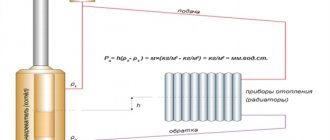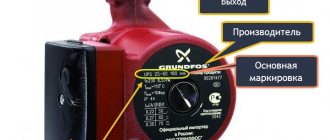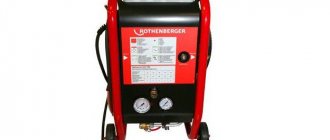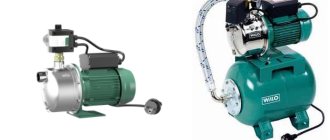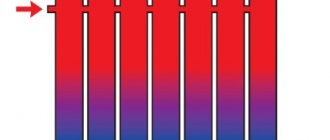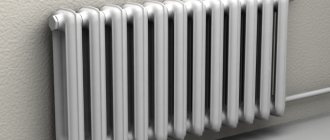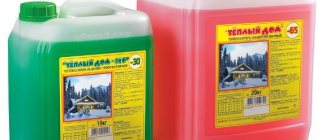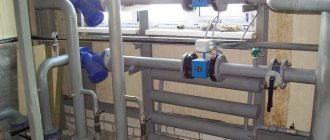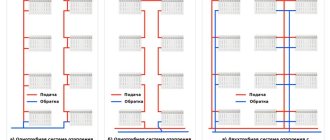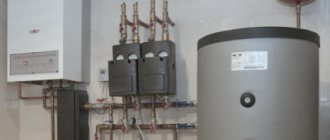The general principle of operation of all water heating systems is the same: the coolant is heated in the boiler and moves through the pipes to the radiators, transfers heat to the room, and then returns to the boiler. In this case, circulation can be natural or forced. It all depends on what sets the coolant in motion. In the first case it is gravity, in the second it is a pump.
Natural circulation systems
Systems with natural circulation, due to their characteristics, are more suitable only for houses with a total area of up to 200 square meters. m, or rooms with few thermal circuits. In addition, they will require large diameter pipes (at least 40-50 mm). Moreover, they are laid at an angle to the horizontal plane so that the water flows under the influence of its own weight. Such systems are difficult to regulate, but they are independent of the power supply.
Forced circulation systems
Forced circulation systems are suitable for homes and facilities of any size, they are easily adjustable and more efficient in heat transfer. A great advantage is the comfort of use (the ability to maintain the required temperature in each room). They can use small diameter pipes. In such a system, there is less difference in temperature between supply and processing, which increases the service life of the boiler. The only drawback is the need for uninterrupted power supply.
Heating systems are also available in open and closed types.
:
In the first case, an open expansion tank is used to compensate for the expansion of the coolant (water or antifreeze) in the heating system. In the second, a closed membrane tank is used.
In an open system, the expansion tank should be installed at the highest point of the system. In a closed one, there is no need to place a membrane tank at the top. A system with a closed membrane tank has many advantages compared to an open one. Here are the main ones: the tank can be placed near the boiler, there is no need to pull and insulate the pipe into the attic, pressure is created throughout the entire system, which promotes uniform operation of all radiators, there is no evaporation of steam or liquids. Open systems are rarely used these days.
Circulation type
As mentioned earlier, water heating operates by moving coolant through the system. Now we will look at existing types of water circulation, which have fundamental differences that must be taken into account when choosing a scheme.
Natural (gravity)
In this case, the heating process consists of different densities of hot and cold coolant.
The heated liquid loses its density and decreases in weight, so it is pushed upward, flowing through the pipeline. Having given off heat and lowered the temperature, the water becomes denser, sinks down and goes back into the boiler.
The advantages of a natural water heating system include its autonomy, since it does not require electricity, and a very simple design.
If we talk about the disadvantages, then an impressive number of pipes with a large diameter will be required, otherwise the process of gravity will be disrupted, and modern radiators with a small cross-section simply will not be able to dock with the main line. Also, when installing the pipeline, it is necessary to ensure a slope of 2°, which will facilitate the correct operation of the system.
Forced
Water flows through the pipeline using a circulation pump. The excess coolant mass that forms after heating is discharged into the expansion tank (in most cases a closed design), which prevents evaporation of the liquid.
This rule especially applies to those cases when glycol compounds are used as a coolant. The pressure in forced heating systems must be controlled using a pressure gauge.
The advantages of such a water heating system are very obvious and consist in a small volume of coolant with a low flow rate of pipes, the diameter of which is inferior to the previous option.
Also here it becomes possible to set the desired heating temperature for radiators, which can be of absolutely any type. The disadvantage is the dependence on the power supply, without which the pump cannot operate.
Types of pipe layouts in heating systems
Based on the type of pipeline design, systems are divided into single-pipe and two-pipe. Single-pipe systems are different:
With bottom wiring (popularly often called Leningradka) when the heating pipeline passes through the entire house or facility in a circle, returning to the boiler. Heating devices are attached to the heating bed; there is an option when the pipeline passes directly through the radiators. Sometimes such a system is used on several floors, making each floor its own circuit. Advantages of Leningrad: a small number of pipes, no risers, you can position the system without spoiling the design (when there is no way to hide the pipes). Minus the large diameter of the pipes, uneven heat distribution (the first devices are hot, the last ones are cold), the inability to regulate the system. Second
type of single-pipe systems - with top wiring (called Moscow system), when the heating pipeline runs along the top of the room and returns to the boiler through the bottom.
The batteries sit on risers that connect the supply and processing. Plus, such a system has the ability to work without electricity, temperature uniformity across the batteries is achieved using different pipe diameters and thermal calculation of the number of sections (and the number of sections in the same rooms will vary and depends on many characteristics). The disadvantage
of the system is the difficulty of accurately adjusting the system; heating risers and beds disrupt the design (if it is not possible to hide it in the walls).
In Siberia, this is a frequently used scheme in private homes (many of our clients use this particular scheme if there are power outages). Two-pipe heating systems also come in several types: manifold or fan pipe distribution. It is often also called beam or cabinet. This system is the most popular in cottages and buildings. The meaning of the collector system is that on each floor there is one or several cabinets with collectors, and from these collectors supply and treatment pipelines extend to each heating device.
System type
Having become familiar with the methods of coolant circulation through the mains, it is worth knowing that the circuit of a water heating system can be single-pipe, double-pipe or collector. Let's look at all three options in more detail.
One pipe
In this case, the water moves sequentially from radiator to radiator, losing temperature along the way, making each subsequent battery colder.
This negatively affects the achievement of a comfortable climate in the rooms.
Two pipes
This scheme is characterized by better heating of the premises. It provides for the installation of two pipes that are connected to each radiator. One of them supplies the batteries with hot coolant, and the second takes the cooled water back to the boiler, so heat loss will be minimal.
Collector
The most effective option, in which a mandatory element is a manifold that separately supplies a pipe with hot water to each heating element. Another pipe returns the cooled coolant back.
Considering this feature, it is possible to carry out repairs and set the temperature of each radiator separately, without taking the entire circuit out of service. Unfortunately, here the pipe consumption increases significantly and it becomes necessary to install a manifold cabinet.
Radial floor wiring
It happens when all the collectors are assembled in the boiler room. The advantages of fan wiring: each device can be turned off separately or adjusted by temperature, all pipelines can be laid in the floor, the system does not spoil the design of the premises, it is easy to calculate when designing, the ability to automate the system. Cons: more pipes, higher system costs. Sequential two-pipe system.
Often a classic two-pipe heating system with bottom wiring in residential apartment buildings. Heating pipelines are laid under the ceiling of the basement floor (in a false ceiling or open) or in the floor structure of the basement floor; heating risers are connected to them, providing heating fluids with coolant.
It is advisable to design this scheme for heating large country houses (from 1500 sq. m.), in the presence of an operation service. The advantage of this scheme is that in residential premises there are only heating devices, there are no cabinets, the floor screed is reduced (no space is needed for laying heating pipelines), in terms of material, relative to the manifold scheme, it is more profitable. Since this is a two-pipe circuit, the temperature difference across the device is constant, and if desired, each device can be turned off to replace it without stopping the entire heating system of the country house. In places where the drain is connected to the main line (on the ground floor), differential pressure regulators (balancing valves) are often installed - they can create a large local resistance and hydraulically equalize all risers in the building. One of the varieties of a two-pipe sequential system is a floor-to-floor heating system. The meaning of this system is as follows: a riser is raised from the boiler, and heating lines are laid on each floor along the perimeter of the house with heating devices connected in series to them. The main criterion for using this scheme is that the pipelines are located near the outer wall of the house and do not interfere with anyone or anything, and ease of installation - all pipelines are located near the floor, construction work is kept to a minimum (no grooves, niches for built-in cabinets), it is possible to turn it off each floor is separate, not expensive to install (relative to a cabinet layout). In addition to serial and radial pipe routing, in our work we often come across a “combined” type of routing. It is used in the case when, with radial wiring to one collector ring, several radiators are powered. As a rule, these radiators are located in close proximity to each other (in the same room). Or a combined collector type, when supply and treatment distribution manifolds are installed in the boiler room, and then the pipelines diverge along the circuits (to different rooms or even different objects). This system is effective in large cottages and buildings where there are many different thermal circuits or several rooms. Possibility of setting different temperatures in different rooms, inexpensive system to install.
There is also a collector type using a hydraulic arrow, when the boiler and the collector are powered in a circle by one circuit (primary circuit), and secondary circuits diverge to the heating system. Good to use when high processing temperatures are required. It is not yet widely used in Siberia due to the high cost of the system, but it is easy to set up and adjust. Our company’s specialists can correctly select, calculate (free of charge) and install the optimal heating system. CALL
Share on social media networks:

